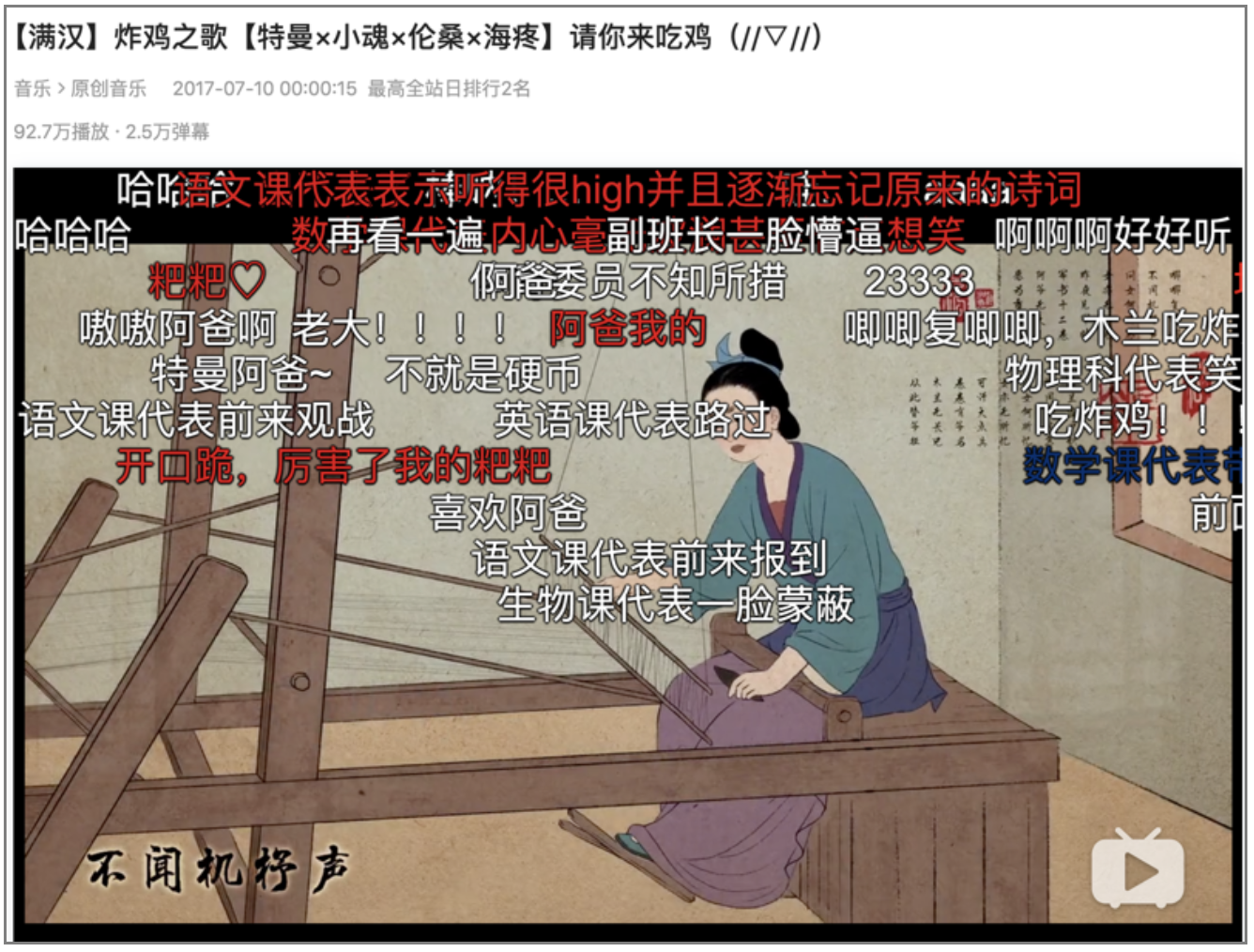
albert Chan
Bilibili is a video-sharing website and app where the majority of content is themed around animation, comics and gaming (ACG). With Bilibili, viewers can add instant comments that move from left to right on the screen. Different from video-sharing platforms such as Youku and iQiy—which host professionally produced videos licensed from content partners—Bilibili is similar to YouTube in that it encourages the upload of user-generated content.
What is Bilibili?
Founded by Xu Yi in 2009, Bilibili models itself on the early days of Japanese ACG video portal Niconico with its integration of danmu (弹幕, “bullet comments” in English or “danmaku” in Japanese), which allows real-time comments from viewers to fly across the screen like bullets. Each comment is synchronized to an exact moment in the video and will fly across the screen on cue on every subsequent replay.
This feature makes users feel like they are watching their favourite television shows with friends, as they can interact with each other via comments. It helps Bilibili to attain a higher user-retention rate, because users who post their bullet comments are more likely to watch the video again just to see others’ responses. Moreover, when users discover a show they love on Bilibili, they may watch them all again in order to see if other viewers have the same opinions.
On particularly popular videos, comments from viewers pile up so thick that they can cover the original content entirely.
[caption id="attachment_98015" align="aligncenter" width="650"] Video on Bilibili with bullet comments
Video on Bilibili with bullet commentsSource: Bilibili website[/caption]
Bilibili’s ACG focus has attracted many of those who were born after 1990. For Chinese kids growing up during the 1990s, manga and anime series such as Doraemon and One Piece became important cultural benchmarks. Bilibili reported its monthly active users exceeded 11 million as of June 2019, and the majority of those (82.1%) were born between 1990 and 2009, according to the company. The ACG focus is often referred to as the “two-dimensional space” (二次元), marking its distinction from the real-world, three-dimensional space.
Bilibili said in June 2019 that its users spend an average of 78 minutes per day on the video-sharing platform. Given the popularity of the site among young people, even government entities are opting in, in an attempt to reach the younger demographic. China’s Central Communist Youth League established its presence on Bilibili to better propagate its message to young people via animated videos.
[caption id="attachment_98016" align="aligncenter" width="550"] Account of China’s Central Communist Youth League on Bilibili
Account of China’s Central Communist Youth League on BilibiliSource: Bilibili website[/caption]
Using Bilibili Animation as a Product Marketing Tool
Bilibili offers brands and retailers opportunities to advertise their products. Companies can create their own marketing videos featuring anime figures or collaborate with content producers through the video-sharing platform.
In January 2019, Japanese cup noodles manufacturer Nissin Foods cooperated with the popular animation series “Koizumi-san who loves eating ramen” on Bilibili to launch a limited-edition product. All 600,000 limited-edition cup noodles sold out within three months of the product’s launch, according to Nissin Foods.
[caption id="attachment_98017" align="aligncenter" width="650"] Nissin Foods’ limited-edition cup noodles were promoted using animated figure Koizumi-san
Nissin Foods’ limited-edition cup noodles were promoted using animated figure Koizumi-sanSource: Nissin Foods[/caption]
Hong Kong beverage company Vitasoy worked with “vocaloid” (animated virtual idols) project Vsinger to release a music video to promote Vitasoy lemon tea on Bilibili. Vsinger has been very popular among young people, with one vocaloid, Luo Tianyi, gaining 4.5 million followers on Weibo as of October 3, 2019. The Weibo account is managed by the company that created Vsinger: Shanghai Henian Information Technology.
[caption id="attachment_98018" align="aligncenter" width="650"] Vitasoy’s video advert contains Vsinger virtual idols
Vitasoy’s video advert contains Vsinger virtual idolsSource: Vitasoy[/caption]
In 2018, Kotex worked with Bilibili to market its products in a side story of the popular animated series Citrus. The show was ranked as the third most popular animated series among viewers as of January 2018, according to Anime Trending.
[caption id="attachment_98019" align="aligncenter" width="650"] Kotex’s ad in the side story of animated series Citrus on Bilibili
Kotex’s ad in the side story of animated series Citrus on BilibiliSource: Bilibili[/caption]
In July 2017, KFC invited Bilibili’s content creator Man Han’s music team (满汉全席音乐团队)to produce a music video with ancient animated figures—such as heroine Mulan—to promote its fried chicken. The video was played 927,000 times, and 25,000 bullet comments had been added as of October 4, 2019. At its peak, KFC’s video reached the second most-played ranking on Bilibili, according to the video platform.
[caption id="attachment_98020" align="aligncenter" width="650"] KFC’s music video with an anime figure originating from traditional Chinese culture
KFC’s music video with an anime figure originating from traditional Chinese cultureSource: Bilibili[/caption]
Retailers Open Physical Stores with Bilibili
Retailers can also cooperate with Bilibili to open animation-themed stores to attract young consumers. Around 68% of young people surveyed said they would likely buy animation-related services and products, according to marketing agency AdMaster.
UK-based coffee chain Costa Coffee collaborated with Bilibili to open a themed café in Shanghai in February 2018. The café included many popular Bilibili icons, including its two virtual ambassadors “22 lady” and “33 lady.”
[caption id="attachment_98021" align="aligncenter" width="700"] Costa’s Bilibili-themed café
Costa’s Bilibili-themed caféSource: Bilibili website[/caption]
Similarly, Japanese convenience-store chain Lawson opened a Bilibili-themed convenience store in Shanghai in January 2018. The store is decorated in Bilibili’s prominent color blue, and cashier staff are dressed as ambassadors 22 lady and 33 lady.
[caption id="attachment_98022" align="aligncenter" width="700"] Lawson’s Bilibili-themed convenience store
Lawson’s Bilibili-themed convenience storeSource: Bilibili website[/caption]
Key Insights
The second-dimensional space economy, which focuses on ACG, reached ¥19.1 billion (around $2.7 billion) in 2018 and is estimated to grow steadily, according to research firm Jiama Data. With the strong potential of the ACG economy and its popularity among young people, brands and retailers can leverage Bilibili to promote their products and offerings to younger consumers in China.